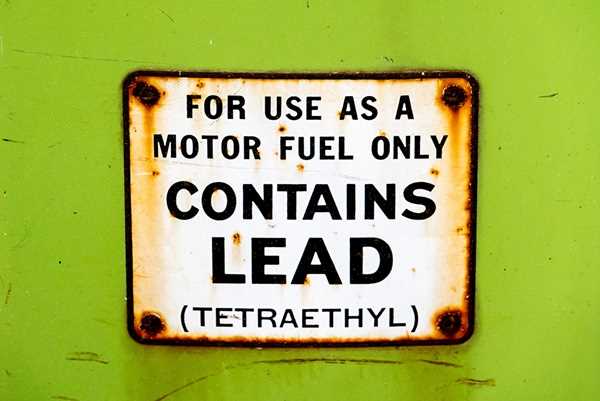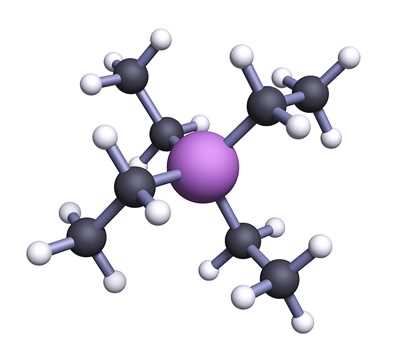EnviroMail 35 Canada -Tetraethyl Lead Testing for Forensic Evidence of Leaded Gasoline & Regulatory Compliance
Testing of environmental waters for Tetraethyl lead (TEL) to sub part-per-trillion levels is necessary to assess regulatory standards in British Columbia and Ontario, and can also be a useful tool for forensic investigation of sites contaminated with gasoline.

Introduction
Definitive detection of TEL in contaminated groundwater plumes at gasoline storage or distribution sites provides evidence of impacts from leaded gasoline, which can help with the determination of historical contamination timelines (especially where free product can be tested).
Tetraethyl Lead History
Tetraethyl lead [Pb(C2H5)4] is an organolead gasoline additive which increases the octane rating of gasoline, slowing its burn rate and allowing higher engine compression ratios while minimizing knock and pre-ignition problems. First used in 1923, TEL was present in most US and Canadian gasolines at up to 3-4 g/gal by 1950. Due to toxicity concerns, unleaded gasoline was introduced in 1971, and TEL concentrations in leaded gasolines were steadily reduced through progressive regulatory reductions until it was phased-out by December 1990 in Canada, by January 1992 in California, and in all remaining US states by January 1996 (Morrison 2006). On August 30, 2021, the United Nations Environment Program (UNEP) finally declared an “official end” to the use of leaded automotive fuels globally. An interesting fact is that the inventor of leaded gasoline, Thomas Midgley Jr., an American engineer, is also credited with invention of the first chlorofluorocarbon (CFC) – the journal New Scientist called him an inventor hero who was a “one-man environmental disaster”.

Human Toxicity
Lead in any form is extremely toxic – a probable human carcinogen associated with heart disease and stroke. Tetraethyl lead is particularly hazardous because it is volatile and can be inhaled as a gas. During early production of TEL for leaded gasoline in 1924, at least 19 TEL workers at 3 facilities died due to lead poisoning, with 73 hospitalized – some becoming violently insane (Kovarik 2005). Even at very low levels, lead causes neurodevelopmental and behavioural effects in children, and is strongly linked to reduced IQ scores. Health Canada guidelines state that “the threshold below which lead is no longer associated with adverse neurodevelopmental effects cannot be identified” (Health Canada 2019). Human exposures from leaded gas were ubiquitous during its use, especially in urban areas, as shown by a drop in median US blood lead levels by more than 80% from 1977 to 1987 while leaded gasoline was phased out (Lovei 1999). Particularly due to its developmental effects on children, the use of leaded gasoline over almost a century has been called an international public health disaster.
Environmental Fate of TEL
When burned in automotive gasoline, TEL converts to inorganic lead compounds such as lead oxide, which are released to the environment in exhaust gases, leading to lead contamination of soil or water by deposition. TEL is very stable in gasoline, but in releases of leaded gasoline to subsurface soils, it tends to hydrolyze and progressively dealkylate to ionic organolead substances - first to Triethyl lead (TREL+), then to Diethyl lead (DEL2+), then eventually to the inorganic Pb2+ cation. TEL has very low solubility in water, and will tend to remain associated with residual gasoline contaminants and NAPL (non-aqueous phase layers), which can protect it from degradation. TEL mobility in the subsurface is primarily associated with migration of free-phase gasoline (Mansell 1995).
Definitive GC-ICPMS Analytical Method
ALS Canada now offers one of the most sensitive and definitive test methods for TEL available, using Gas Chromatography with ICPMS detection (GC-ICPMS). Gas chromatography separates individual volatile organic compounds in time, and the ICPMS detector responds only to the unique isotopic masses of lead, with no known interferences. The exceptional sensitivity of this method easily permits assessment of ultra-low regulatory limits (e.g. 0.0010 ug/L for BC CSR, & 0.0007 ug/L for Ontario Interim PWQO) using only 100 mL water samples. Less sensitive TEL test methods typically require much larger sample sizes (e.g. 500 mL – 1 L).

Tetraethyl Lead Molecule
Sample Collection Guidance
Water samples for TEL analysis by the GC-ICPMS method should be collected in 100 mL amber glass containers with Teflon-lined septa (two per sample) with zero headspace. Sample containers are precharged with sodium hydroxide preservative, which must not be rinsed out during sampling. Samples should be chilled to ≤10°C for shipping to the laboratory within 48 hours from sampling.
| Sampling and Method Details (Waters) | |
| Sample container | 2 x 100 mL amber glass, Teflon-lined septa |
| Preservation | Sodium Hydroxide (pH>12), pre-charged, zero headspace |
| Hold time | 14 days to extraction, 40 days for solvent extract |
| Storage Temperature | ≤ 6°C (≤ 10°C during transit to laboratory |
| Test Method | GC-ICPMS |
| Limit of Reporting | 0.0002 ug/L |
The ALS Vancouver laboratory has applied for ISO 17025 accreditation through CALA for TEL in waters. Refer to the ALS Vancouver CALA scope of accreditation for current status. Quantitative TEL testing of free products by the same GC-ICPMS test method is also available if required.
Please contact your ALS Account Manager for additional details or to arrange for sample containers.
References:
- Health Canada, Guidelines for Canadian Drinking Water Quality, Guideline Technical Document, Lead, March 2019.
- Lovei, Magda, Eliminating a Silent Threat, World Bank Support for the Global Phaseout of Lead in Gasoline, World Bank, 1999.
- Kovarik, William, How a Classic Occupational Disease Became an International Public Health Disaster, Int. J. Occup. Environ. Health, Vol. 11/No 4, Oct/Dec 2005.
- Mansell, R.S., Ou, L., Rhue, R.D., Ouyang, Y., The Fate and Behavior of Lead Alkyls in the Subsurface Environment, Battelle Memorial Institute, Nov 1995.
- Morrison, Robert D., Murphy, Brian L., Environmental Forensics, Contaminant Specific Guide, Elsevier 2006.





















































